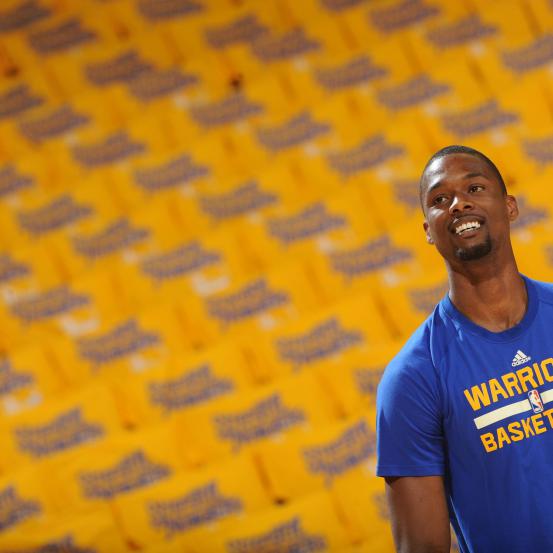- Commissioner’s statement on Ventura, Marte
- Ronnie O’Sullivan: Masters champion ‘felt so vulnerable’ in final
- Arron Fletcher Wins 2017 WSOP International Circuit Marrakech Main Event ($140,224)
- Smith challenges Warner to go big in India
- Moncada No. 1 on MLB Pipeline’s Top 10 2B Prospects list
- Braves land 2 on MLB Pipeline’s Top 10 2B Prospects list
- Kingery makes MLB Pipeline’s Top 10 2B Prospects list
- New Zealand wrap up 2-0 after Bangladesh implosion
- Mathews, Pradeep, Gunathilaka to return to Sri Lanka
- Elliott hopes for rain for Poli
To Max or Not to Max: Is Harrison Barnes Worth Leading-Man Money?
- Updated: May 19, 2016

Andrew Bogut is among the NBA’s ultimate “love him if he’s on your team, hate him if he’s not” players, and not just because of what he does on the court. In Harrison Barnes’ case, Bogut would be a great guy to have in his corner when contract negotiations begin this summer.
As Bogut recently told the San Francisco Chronicle’s Rusty Simmons:
Someone is probably going to give him the max. Let’s be honest. Someone is going to give him close to the max. There’s always a small-market team that would love someone like Harrison as their No. 1 or No. 2 option. I don’t think it’s going to having any bearing on his financial future. I think people know that everyone on this team is more valuable than their contract says – just on the basis of what they’ve given up.
In Oakland, Barnes has blended beautifully as the Warriors’ fourth banana behind Stephen Curry, Klay Thompson and Draymond Green. But there was a time, going back to his days in high school and college, when he seemed destined for top billing.
He was a blue-chip prospect coming out of high school in 2010, became the leading scorer on a loaded squad at North Carolina in 2012 and was, in some ways, the breakout star of Golden State’s 2012-13 postseason run during his rookie season.
Is he ready for that No. 1 role now? If Bogut proves prescient, one team will spend the GDP of a small island nation to find out.
To Max
On paper, Barnes has all the makings of a young player ready to leap up an echelon or two. The Ames, Iowa, native certainly looks and acts the part of a franchise face.
At 6’8″ and a chiseled 225 pounds, with long arms and sky-scraping hops, Barnes has the physical tools to shine at the highest level. Skill-wise, he can do everything a modern three-and-D wing must and then some.
He’s a career 37.6 percent three-point shooter who’s fared better than that over his last two seasons: 40.5 percent in 2014-15; 38.3 percent during 2015-16. Along the way, Barnes has bumped up his accuracy inside the arc as well.
Create line charts
All told, Barnes registered in the top quartile among spot-up shooters in the league, scoring 1.08 points per possession on such attempts.
As Zach Lowe, then with Grantland, noted last September, what sets Barnes apart from the run-of-the-mill wings is what he can do defensively:
…Barnes plausibly defending power forwards is a big part of his value. It separates him from most other spot-up wings, including his current teammates. The Warriors are deep, but Barnes is not redundant — especially as Andre Iguodala ages. If Barnes can defend power forwards, opponents face a choice: go small and risk losing a pace-and-space battle, or ask one of their two bigs to chase a wing player.
In the season since then, Barnes held opposing power forwards to an effective field-goal percentage of 47.6 percent, per 82games.com—well below the league average of 50.2.
Barnes’ ability to hang with bigger forwards allows him and the Warriors to create matchup problems on the other end. He was a crucial cog in the Warriors’ so-called death lineup (Curry, Thompson, Andre Iguodala, Barnes and Green) that demolished the league this season.
But few teams, if any, will have the personnel to downsize that effectively, even with Barnes on board. If he’s going to be a star (and get paid like one), it’ll be by virtue of his ability to score like a No. 1 or No. 2 offensive option.
To that end, Barnes’ superior size comes in handy. He showed off his low-post chops as a rookie during the 2013 playoffs and has since blossomed into one of the Association’s more effective back-to-the-basket operators at his position. According to NBA.com, he scored 0.91 points per possession on post-ups, putting him in the top third of his peers overall.
Share Tweet
Barnes is so dangerous, in the low post and …
continue reading in source www.bleacherreport.com
